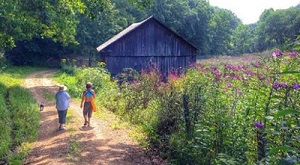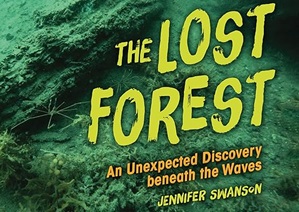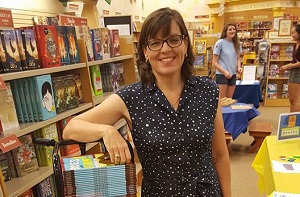We’d like to thank Julie- Zickefoose (juliezickefoose.com) for this blog post. She was on our faculty for The Art & Craft of Nature Writing & Illustration.
Situational awareness, a concept introduced by Sun Tzu inThe Art of War, 6th century B. C., is defined as “The perception of elements in the environment within a volume of time and space, the comprehension of their meaning, and the projection of their status in the near future.”
If this sounds a bit esoteric, I’ll bring it home. People with high situational awareness might include police officers, air traffic controllers, game trackers and guides. These are people who need to be alert to everything going on around them. They need to be able to see possible cause and effect, to make the mental leap to a potential outcome. They notice things.
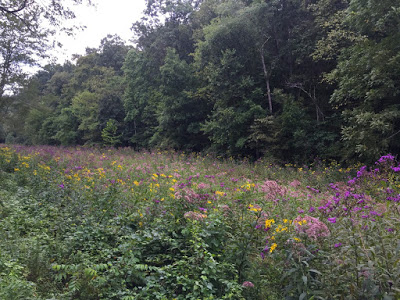
I’ve noticed that late August brings spectacular wildflower blooms in damp meadows.
Situational awareness is the guiding tenet of my life. Noticing things is what I do. Putting two and two together, figuring out what is happening as it’s happening, and why, drives my observation of the natural world. Once I figured out that wild creatures do nothing without some reason, my quest began to figure out the reasons behind the behavior I observed, to become an informed observer of wildlife and natural phenomena.
I was about eight years old when it all came together–when I knew that I could spend all my free time exploring the woods and fields around my suburban Virginia home, and never lack for subjects to study. Birds, mammals, fungi, flowering plants, insects…everything was fair game and all were fascinating. My passion for exploring was a gift to me and a curse to my parents, who had to get used to the idea of their daughter lighting out on a ten-speed 20 miles into the countryside and getting back after dark.
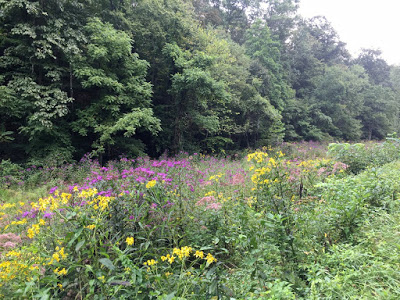
Having noticed this, I purposely seek out wet meadows in late August.
Situational awareness is part of our evolutionary heritage as humans and primates. I fear we are losing it. We spend far too much time with our basic survival senses switched off, sometimes of necessity. We block out industrial noise or other distracting stimuli in the name of “focus.” When we go out in nature, we should strive to turn that workaday mode upside down–when we’re outside, we focus on everything. Small bits of information filter in and mingle in our senses. We never know what bit might help explain something we’ve observed, so we collect them all, continually processing as we make our way along with awareness.
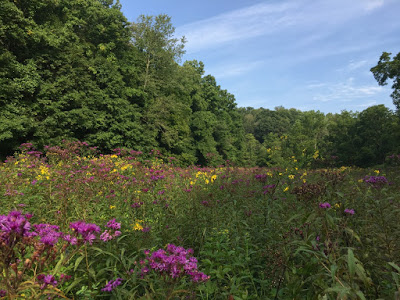
So I get to experience visions like this–tall ironweed and wingstem in fiesta mode.
Getting closer to nature is as simple as walking out the door–devoting time to it. The rewards for “doing nothing” in the outdoors are counted on a scale of well-being and peace of mind that, for me at least, goes up proportionately with the amount of time I devote to being outside. It’s free therapy. Everyone has days when they feel out of control, overwhelmed, bewildered. My answer is to put some miles on the chassis, see how I feel after four. There’s little that can be wrong with me that four miles can’t fix.
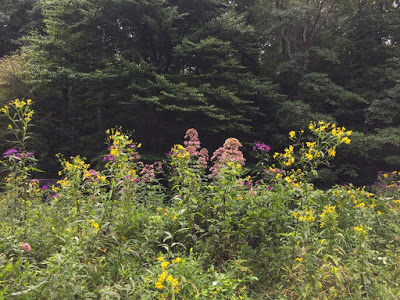
I call it the Ironweed Festival, and I attend every August.
It’s my own little celebration of situational awareness in action. The Ironweed Festival is mine to enjoy because I noticed that this phenomenon was going on; that it repeats yearly, and all I have to do is show up for it.
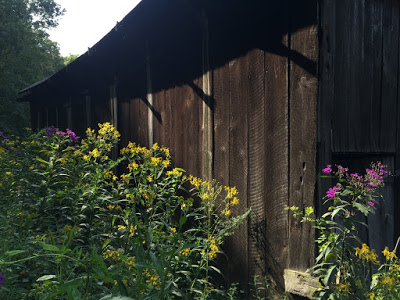
Wingstem and tall ironweed against dark barn siding: so much the better.
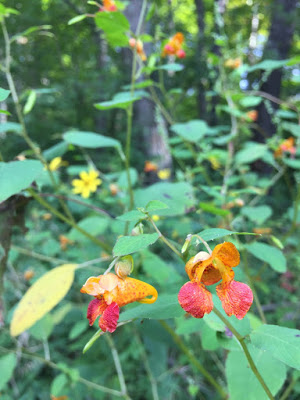
While contemplating the wildflower show near the old barn, I heard the wings of a ruby-throated hummingbird. Remembered having seen some orange jewelweed growing behind the taller plants. Figured the hummingbird would be after it. Swung my binoculars onto the jewelweed, and found the hummingbird working the orange blossoms. You get the picture.
If you’ve been following the photo captions, thanks for coming along! Situational awareness is a difficult concept to illustrate, and I’ve been thinking about this blogpost for a week. I finally decided to take a good hike and see if I couldn’t come up with a concept for the post as I went.
And it unfolded, just as I knew it would. The Ironweed Festival was in full swing down my favorite deserted dirt road. Tall ironweed painted the meadows in royal purple. Because it’s been a wet year, wingstem has come up everywhere, mingling its rich gold amongst the purple and the faded mauve of Joe-pye weed. It’s glorious. Best I’ve ever seen. And I’ve taken three long hikes to appreciate it while it’s happening. That’s situational awareness, put into practice.
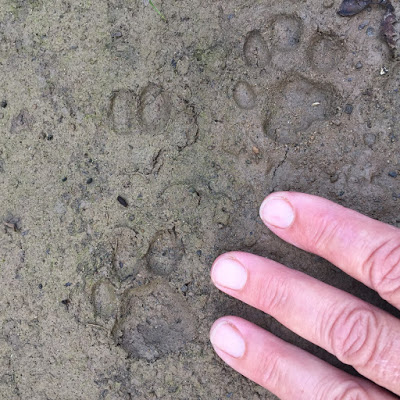
More rewards of being present and noticing things: Bobcat tracks. Clawless and round, these pugmarks are from a smallish cat, perhaps this year’s kitten, or a female.
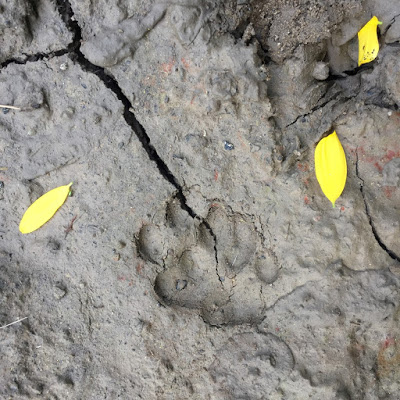
More bobcat tracks. Same animal or a different one? A mile down the creek from the first, with tickseed sunflower petals as garnish. The lesson: Never pass a mud puddle without scrutinizing it for tracks. My corollary: Never let a track go unidentified. This is how we learn.
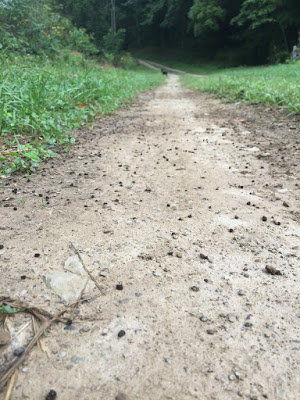
On the same hike, I noticed a LOT of caterpillar droppings, or frass, on a particular stretch of the road.
When I see frass, I look straight up. Frass doesn’t fall far from the caterpillar.
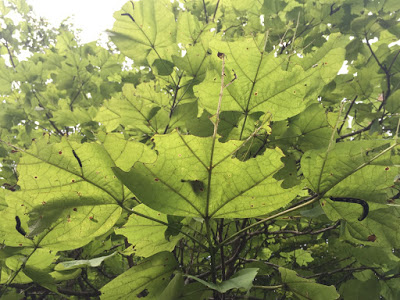
The leaves on the catalpa tree overhead were chewed to pieces. Looking closer, I saw the perps…those black caterpillars. There are three in the photo above.
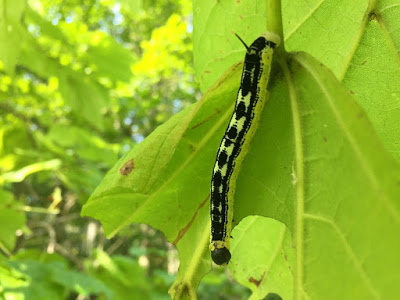
Which, when identified with my Caterpillars of Eastern North America Guide, turned out to be–poof!–Catalpa sphinx! This baby will grow up into a big brown hawkmoth. Isn’t that nice to know?
Knowing what to do when you see frass (look up); looking for caterpillar damage; finding the perps; figuring out what the tree is (we have guides for that, too) and having the right books or resources to puzzle out caterpillar (and track, and bird, and insect, and wildflower) ID…that’s preparedness. That’s situational awareness. That’s paying attention. That’s being present.
Working on your situational awareness is an infinitely expandable, infinitely rewarding way of going through the natural world. Each connection you make informs the next one and enriches your experience.
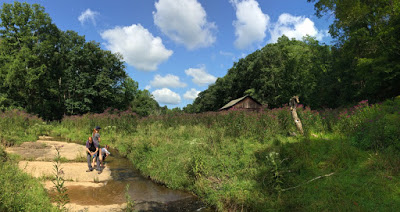
The 2017 Ironweed Festival was sparsely attended, but all agreed that it was the most beautiful ever!

